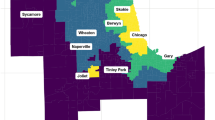Abstract
The impression of journalists and social critics in the 1950’s that post-war suburbia was uniformly middle-class has been generally rejected by social scientists, but there is a persisting belief in a high degree of residential segregation by social level in suburbia and in a high degree of socio-economic homogeneity within suburban neighborhoods. A comparison of eight central cities with their suburban zones in 1950 and in 1960 revealed, for both dates, (a) small differences in occupational distributions between the central cities and the suburban zones and (b) generally higher Index of Residential Dissimilarity values for pairs of occupational groups in the central cities. These findings indicate that suburban neighborhoods, at least in the eight suburban zones studied, were little, if any, more occupationally homogeneous than the central city neighborhoods. This suggests that the belief in homogeneous suburban neighborhoods should be added to the growing list of discredited “myths of suburbia. ”
Similar content being viewed by others
References
Berger, B. M. 1960. Working Class Suburb. Berkeley: University of California Press.
Berger, B. M. 1961. The myth of suburbia. Journal of Social Issues 27:38–49.
Bernard, J. 1962. American Community Behavior. 2nd ed. New York: Holt, Rinehart, and Winston.
Beshers, J. M. 1962. Urban Social Structure. New York: Free Press.
Boskoff, A. 1970. The Sociology of Urban Regions. 2nd ed. New York: Appleton-Century-Crofts.
Broom, L. and P. Selznick. 1968. Sociology. 4th ed. New York: Harper and Row.
Coleman, J. S. 1966. Community disorganization. In R. K. Merton and R. A. Nisbet (eds.), Contemporary Social Problems. 2nd ed. New York: Harcourt, Brace, and World.
Dobriner, W. M. 1963. Class in Suburbia. Englewood Cliffs: Prentice-Hall.
Duncan, O. D. and B. Duncan. 1955. Residential distribution and occupational stratification. American Journal of Sociology 60:493–503.
Farley, R. 1964. Suburban persistence. American Sociological Review 29:38–47.
Fava, S. F. 1956. Suburbanism as a way of life. American Sociological Review 21:34–37.
Goldstein, S. and K. Mayer. 1964. Population decline and the social and economic structure of the American city. American Sociological Review 29:48–54.
Lazerwitz, B. 1960. Metropolitan residential belts, 1950 and 1956. American Sociological Review 25:245–252.
Lee, D. 1963. Suburbia reconsidered: diversity and the creative life. In E. Green (ed.), Man and the Modern City, Pittsburgh: University of Pittsburgh Press.
Martin, W. 1956. The structuring of social relationships engendered by suburban residence. American Sociological Review 21: 446–453.
Packard, V. 1959. The Status Seekers. New York: McKay.
Riesman, D. 1957. The suburban dislocation. Annals of the American Academy of Political and Social Science 314:123–143.
Schnore, L. 1963. The socio-economic status of cities and suburbs. American Sociological Review 28:76–85.
Whyte, W. H. 1956. The Organization Man. New York: Simon and Schuster.
Wood, R. C. 1959. Suburbia: Its People and Their Politics. Boston: Houghton Mifflin.
Wrong, D. H. 1967. Suburbs and myths of suburbia. In D. H. Wrong and H. L. Gracey (eds.), Readings in Introductory Sociology. New York: Macmillan.
Author information
Authors and Affiliations
Rights and permissions
About this article
Cite this article
Fine, J., Glenn, N.D. & Kenneth Monts, J. The residential segregation of occupational groups in central cities and suburbs. Demography 8, 91–101 (1971). https://doi.org/10.2307/2060341
Issue Date:
DOI: https://doi.org/10.2307/2060341




